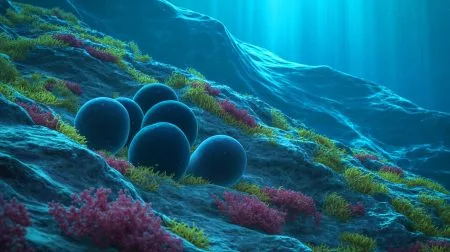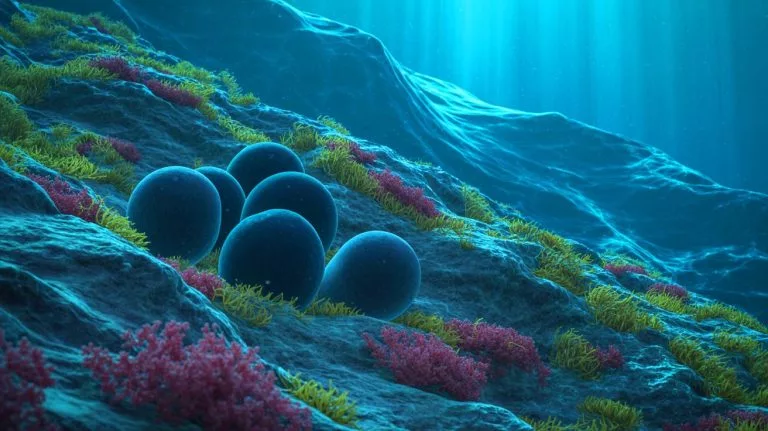| IN A NUTSHELL |
|
In a groundbreaking discovery, scientists have uncovered enigmatic black egg capsules at a remarkable depth of 20,300 feet beneath the Pacific Ocean. This discovery, made in the Kuril-Kamchatka Trench, marks the deepest known reproduction of free-living flatworms. The finding not only challenges our understanding of marine life at such extreme depths but also sheds light on the resilience and adaptability of these seemingly simple organisms. The capsules, initially mistaken for fish eggs, were found to contain flatworm embryos, revealing a complex life cycle previously unknown in such harsh environments.
The Deepest Flatworm Reproduction Ever Recorded
At an astounding depth of nearly 20,300 feet, where few organisms have been documented, researchers from the University of Tokyo and Hokkaido University made a surprising discovery. Using a remotely operated vehicle (ROV), they identified four glossy black spheres clinging to a rocky slope. These spheres, unlike anything previously encountered, turned out to be cocoons of free-living flatworms, not fish eggs as initially assumed.
Upon retrieval and examination at the surface, each capsule revealed three to seven embryos in various stages of development. Some embryos remained spherical, while others had elongated into worm-like forms. The presence of these cocoons at such depths represents the deepest record for flatworm reproduction, nearly doubling the previous record held by Oligocladus voightae at 10,600 feet in the Escanaba Trough. This discovery opens a new window into the life cycles of organisms at abyssal and hadal depths that were previously only theoretical.
What These Embryos Reveal About Life Under Extreme Pressure
The genetic analysis traced the embryos to the Tricladida order, specifically the Maricola suborder, which includes marine flatworms typically found in coastal settings. This phylogenetic placement suggests these animals did not evolve in the deep sea but descended from shallower ecosystems. This finding supports theories that many hadal zone species have shallow-water ancestors and have adapted to the extreme pressures and minimal resources of their new environment without major evolutionary changes.
Interestingly, the embryos inside the black cocoons showed no unusual larval forms or unique body structures. Their development mirrored that of their shallow-water relatives, emphasizing that simple organisms can thrive in diverse environments without significant evolutionary alterations. This resilience highlights the importance of physiological adaptations over structural changes in surviving extreme conditions.
The Kuril-Kamchatka Trench: A Hidden Cradle of Biodiversity
The Kuril-Kamchatka Trench, with depths exceeding 31,000 feet, remains one of Earth’s least explored regions. The area where these cocoons were found, the abyssal slope, ranges from 11,300 to over 20,000 feet, suggesting a rich but largely undocumented biosphere. Traditional methods like trawls or grabs often destroy fragile deep-sea organisms, making the intact discovery of these egg capsules particularly significant.
The capsules provide a preserved view of early developmental stages, crucial for understanding how species persist in such challenging environments. This discovery sheds light on a reproductive strategy that favors endurance: hard protective shells, multiple embryos per capsule, and attachment to rocky surfaces. In these high-pressure, food-poor environments, slow, protected development might offer the best survival strategy.
Why Flatworms Still Matter to Science
Despite their simplicity, free-living flatworms are of significant scientific interest due to their remarkable ability to regenerate body parts. This trait makes them ideal models for studying morphogenesis, cell differentiation, and body plan resilience under stress. The study integrates field collection data and molecular analysis, laying the foundation for future research and the development of improved ROV technologies.
Genetic tools are increasingly crucial in mapping biodiversity in remote environments where traditional methods fall short. The combination of morphological data, genetic sequencing, and deep-sea imaging sets a new precedent for future studies, particularly in hadal environments. Each documented find acts as an anchor point for comparison and further research, enhancing our understanding of life in Earth’s most extreme habitats.
The discovery of these black egg capsules in the Kuril-Kamchatka Trench challenges our perceptions of life at extreme depths. As scientists continue to explore these mysterious environments, they will undoubtedly uncover more secrets about the resilience and adaptability of life. What other surprises might the ocean depths hold, and how will they reshape our understanding of marine biology?
Did you like it? 4.4/5 (22)






Wow, they’re not fish eggs? That’s incredible! Just when you think you’ve seen it all, nature surprises you. 🐍
Wow, that’s fascinating! How do scientists even reach such depths to study these embryos? 🐠
So, are these flatworms dangerous to humans? They sound a bit creepy! 😅
I never knew flatworms could live so deep in the ocean. What are their predators at such depths?
Could this discovery lead to new insights into climate change and its effects on marine life?
Wait, 20,300 feet? That’s deeper than the Titanic wreck! Incredible. 🚢
So, were these embryos in any danger of hatching in the lab? 😅
Were the scientists expecting to find anything at all down there, or was this a complete surprise?